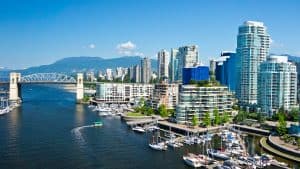GREEN Building for the GREEN City
Building Design Plays a Crucial Role in Green Cities
Many industries are searching for pollution reduction techniques as the eco-conscious movement grows. When the United Nations (UN) established the Paris Agreement in 2015, countries began seeking sustainability-enhancing infrastructure to support emission reduction efforts. Environmental architects and scientists have developed different building methods, helping regions construct green cities with limited ecological impacts.
What Is a Green City?

Eco-conscious engineers and architects created the green city design to reduce adverse environmental effects. It incorporates technologically advanced systems and appliances that increase energy and water efficiency.
The green city model also uses strategic, sustainable building techniques to reduce atmospheric and surface-level pollution. Professionals target emissions deriving from unnecessary energy uses and sources that harm the environment.
Nearly 80% of the global energy supply comes from fossil fuels. When buildings run their heating, ventilation, and air conditioning (HVAC) systems and power their lights, they contribute to electricity-related emissions. Fossil fuels emit greenhouse gases into the atmosphere when producing electricity. They accumulate in the environment and limit Earth’s ability to sustain life-sufficient surface temperatures. Over time, the enhanced greenhouse effect causes global ecological degradation.
What Is a Net-Zero Building Design?
The most advanced green building design is the net-zero version. The structures are self-sufficient, producing as much clean energy as they consume. Net-zero buildings utilize energy-efficient technology to reduce emissions and strain on renewable power systems.
Architects also design them to reach carbon neutrality, minimizing the enhanced greenhouse effect. Additionally, they access water from alternative supplies to eliminate resource exploitation.
Renewable Energy
One common aspect of green cities is their reliance on emission-free energy sources. Many net-zero buildings rely on photovoltaic (PV) solar panels to power their systems and appliances. PV cells absorb photons from the sun, using them to knock electrons loose.
As the electrons move throughout the system, they create a current. Transfer wires capture the current and convert it into accessible electricity. Many architects line rooftops with PV panels, capturing direct sunlight and producing abundant amounts of clean electricity.
They also power net-zero buildings’ HVAC systems using geothermal energy. The technology relies on the planet’s natural temperature differentiations. Installation professionals place pipes beneath Earth’s surface, filtering heating and cooling agents through them.
Once the fluids reach a specific temperature, they move through a transfer system, pushing controlled air into the building. Geothermal HVAC systems produce little to no greenhouse gas emissions, improving their sustainability.
Sustainable Building Materials
Construction professionals must utilize low-impact materials when they craft sustainable buildings. Consciously produced aluminum is gaining popularity in the construction sector — manufacturers create the material using hydropower to shrink its carbon footprint. Aluminum is a strong and reliable building component, helping construction professionals create sustainable and long-lasting structures.
Builders can also develop eco-friendly buildings using repurposed wood. Construction professionals can obtain recycled wood and other materials using the deconstruction method.
Builders practice deconstruction by carefully pulling apart buildings at the end of their life cycles. They salvage as many materials as possible during the process to minimize waste. Individuals can reuse a building’s components to improve its sustainability.
Another recycled material builders can use when producing net-zero buildings is cellulose insulation. The product is made from old newspapers, reducing municipal waste and improving a structure’s energy efficiency. Adding insulation to a building effectively reduces HVAC emissions.
Green concrete is an additional sustainable building material shrinking a structure’s carbon footprint. Manufacturers produce the construction component using alternative energy and carbon capturing, reducing emissions by 30% on average.
Builders that utilize different sustainable materials can significantly reduce atmospheric and surface-level pollution.
Energy Efficient Lighting
HVAC systems and lighting account for the most significant quantity of a building’s energy use. Individuals can install light-emitting diode (LED) bulbs to reduce a structure’s power reliance. LED lights are nearly 90% more energy efficient compared to incandescent bulbs.
Architects can utilize the efficiency-enhancing technology indoors along with natural lighting. They may also place LED bulbs around a green city in streetlights, reducing general emissions.
Individuals can also install smart blinds to improve net-zero buildings’ sustainability. They make the most of natural lighting by using sensors to open at different times throughout the day to reduce the need for artificial light.
Sustainable technology can also be controlled by a smartphone. Individuals can use the application to change its settings from anywhere. They may also program the device through the app, controlling when blinds open and clothes. Over time, the system effectively enhances a building’s energy efficiency.
Additional Green City Features
Green cities contain other features that reduce their carbon and water footprints. Electric transportation systems are gaining popularity globally, improving local air quality and minimizing ecological degradation. Sustainable cities also support circular economies by influencing material reuse.
Many eco-friendly regions reduce transportation emissions and resource exploitation by increasing vegetation and agricultural production. Over time, researchers predict green cities may begin popping up worldwide, supporting green employment as they expand.
Article by Jane Marsh
Author bio:
Jane works as an environmental and energy writer. She is also the founder and editor-in-chief of